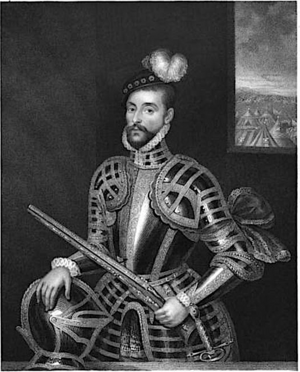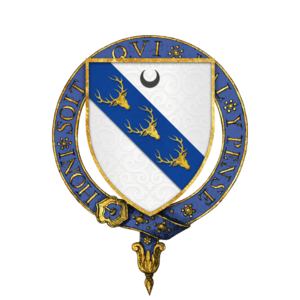William Stanley (died 1495) facts for kids
Sir William Stanley (around 1435 – 16 February 1495) was an English soldier. He was the younger brother of Thomas Stanley, 1st Earl of Derby. Sir William fought in many battles during the Wars of the Roses, a long conflict over who should rule England.
Contents
Who Was Sir William Stanley?
Sir William Stanley was born in Latham, Lancashire. His father was Thomas Stanley, 1st Baron Stanley. Sir William married twice. His first wife was Joan, and later he married Elizabeth Hopton. They had a daughter named Jane Stanley. Their home was at Holt, Wrexham.
Stanley's Role in the Wars of the Roses
Sir William Stanley was a key figure in the Wars of the Roses. This was a series of battles between two powerful families, the House of York and the House of Lancaster, who both wanted the English throne.
Fighting for the Yorkists
At first, William Stanley fought for the Yorkist side.
- Battle of Blore Heath (1459): He fought for the Yorkists. Interestingly, his older brother, Thomas, did not join either side in this battle.
- Battle of Towton (1461): After being forced to leave England for a short time, Sir William returned and fought for the Yorkists again.
- Capturing Queen Margaret (1471): After the Battle of Tewkesbury, Sir William captured Queen Margaret of Anjou. She was a leader of the Lancastrian family. For his bravery, the king made him a Knight Banneret, which was a special honor for a knight.
Rewards for Loyalty
The Yorkist kings rewarded Sir William for his loyalty.
- Land and Castle: In 1465, he was given the Skipton lands and castle. These had belonged to a Lancastrian family.
- Chief Justice: In 1483, he became the Chief Justice of North Wales. This was an important job in the legal system.
- More Land: When Richard III became king, he also gave Sir William more land in North Wales.
A Change of Sides
Even though he had been loyal to Richard III, Sir William Stanley made a big decision in 1485. He decided to support Henry Tudor, who was trying to become king and was from the Lancastrian side.
The Battle of Bosworth
Sir William is most famous for what he did at the Battle of Bosworth. This battle was very important because it decided who would be the next king.
- Decisive Attack: During the battle, Sir William suddenly attacked the Yorkist army led by King Richard III. This attack helped Henry Tudor win the battle.
- Brother's Position: His older brother, Thomas, could not join the fight right away. This was because King Richard III was holding Thomas's son hostage.
Rewards from the New King
After Henry Tudor became King Henry VII, he was very grateful to Sir William.
- Lord Chamberlain: Sir William was given important jobs, including the Lord Chamberlain. This was a high-ranking position in the royal household.
- Chamberlain of the Exchequer: He also became the Chamberlain of the Exchequer, which involved managing the king's money.
Why Was Sir William Stanley Executed?
In 1495, Sir William Stanley faced a serious problem. He was accused of supporting someone named Perkin Warbeck. Warbeck claimed to be a prince who should be king, but he was actually an imposter.
- Accusation and Confession: Sir William was accused of supporting Warbeck. He admitted to it, hoping that by telling the truth, he would not be punished too harshly.
- King Henry's Decision: King Henry VII thought carefully about what to do. He did not want to upset his mother or his stepfather (who was Sir William's brother). However, the King worried that if he showed mercy, other people might try to plot against him.
- Execution: Because of this, Sir William was sentenced to death. A few days later, he was beheaded.
Images for kids





